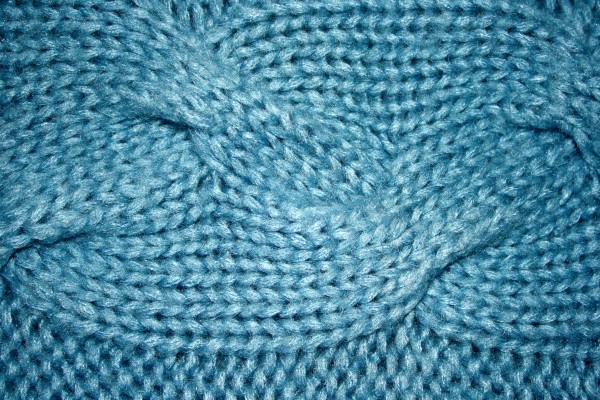 |
| Public Domain Photograph of Cable Knitting |
Basic cables are formed by deliberately working stitches out of sequence. The greater the number of stitches worked in a cable, the denser the fabric. Conventionally, basic cables are worked on a background of purl stitches (and sometimes, seed stitch). Combined with the correct yarn choice, this flat background makes the cables pop, so that they are the focus of your knitting.
In the class
sampler, we are working a band of sample cables. The cables are made using a base of 6
stockinette stitches surrounded by P2, K2 ribbing. Because we want purl stitches on either side
of the cables, our right side row begins with P2, K2, P2. The 6 stockinette stitches are in the middle
and the band ends with P2, K2, P2. Our
pattern is worked only on those middle 6 stitches; everything else remains as
ribbing.
In order to
see how cables are formed, you can begin by working twisted stitches, pairs of
stitches in which the second stitch on the left hand needle is knitted before the
first stitch on the left hand needle. To
produce a twist to the right, you knit the second stitch on the left hand needle
through the front, just as you would normally.
You then swing your right hand needle tip around to knit the first
stitch from the left hand needle and slip the two knitted stitches from the
left hand needle. Be careful not to work
both stitches at once and to go into each stitch as you work it, not between.
A twist to
the left is made by knitting into the second stitch on the left hand needle
from the back and then knitting the first stitch on the left hand needle from
the front, then slipping both worked stitches from the left hand needle.
Simple,
yes? Technically, twisted stitches are
not considered to be cables because they can be worked in a variety of ways to produce
fabric in a class of its own. They are
an easy way to transition into true cables, which involve the same principle of
working groups of stitches on the left hand needle before the first set of
stitches on the left hand needle.
Once you
have tried some twisted stitches, you’re ready to begin knitting simple
stockinette cables. I’ve included two
links here to help you. Theresa
Stenersen has written an excellent article on cables which was published in the
Winter 2007 issue of Knitty. You can find the article by clicking here.
Eunny Jang,
from Interweave Press KnittingDailyTV.com,
demonstrates knitting a basic cable in the YouTube clip below. Note that Eunny recommends using a singles
yarn and, while singles will work in
cables (I used one for my hat), I don’t advise choosing singles for your first
cables because the yarn tends to split easily.
There are
other excellent articles and videos on knitting cables. Have a look around on the ‘Net, try things out for yourself and, most of all,
have fun!
Namaste.

Do you use a cable needle? I've been working on cabling without one but I still like my cable needle most of the time.
ReplyDeleteI prefer using a cable needle. Then again, I like to knit socks from the top down on dpn's!
DeleteCables are my favorite, and it's one thing to know how to do them, but it's so exhilirating when you realize that you also understand them. Reading cables was a huge breakthrough for me. This post captures that feeling so well :)
ReplyDeleteI attempt to teach people how to "read" the fabric, not rely on the instructions. Cables look so impressive, but they're really quite simple to do.
Delete